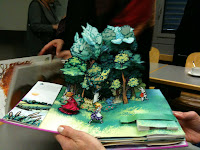I wrote last week about some worrying trends with picture books and asked 'Are Picture Books Dying?' My post was motivated by my concern that the picture book is seriously under-valued by some parents and teachers and yet, I believe that it offers things that chapter books can't for young readers. You can read it if you missed it HERE.
But in this post I address a different question. Is it possible that new technology could enhance the picture book? Regular readers of this blog would be surprised that I'm even asking the question. There have been many attempts in recent years to produce electronic versions of picture books, but so far few have done more than put picture books on a screen with a few minor enhancements, often as small as allowing text size or font to be changed (this is not to deny that this is useful).
There are of course some practical problems if electronic books are going to work with young children. Will they pass the cereal and bath tests? Will kids be able to chew them, sleep with them and could they survive if left in the back seat of the car in summer? At the moment I can't see us letting toddlers drag around our iPads, but with technology advances it just might happen sooner than we think.
I don't think for a minute that technology will kill off picture books, but it might just open up a few new possibilities for using them and for combining image and word. I wouldn't have thought this until I saw the latest example of a picture book on iPad that tries to integrate image, word and sound in new ways. Have a look at the preview below of 'Alice in Wonderland' for iPad.
I'm grateful to Stella Reinhard one of the speakers at the '8th International Conference on the Book', which I just attended in St Gallen Switzerland who shared the above video clip. I also presented a paper on the 'Power of Literature' that I might blog on later. Stella presented a paper on the traditional pop-up book and showed us some of the wonderful examples that have been produced over a period of 200 years.
The extent of the paper engineering is quite extraordinary, as the creators have tried to add movement and dramatic effect to support the text. The examples opposite and below are both from legendary 'pop-up' book creator Robert Sabuda's well-known version of 'Alice in Wonderland'. But as much as these wonderful books are interesting and exciting for children (and adults!), are they ever more than a novelty? I think the answer is both yes and no. They are a novelty, but this doesn't mean that their impact is trivial and unimportant.
I'm reminded of one of my grandchildren, Elsie who is now almost 4 years old and loves books. In the family Christmas letter of 2007 her mother and my daughter (Nicole) wrote something about every family member's favourite books in the year past. For Elsie she wrote, "Elsie likes pretty much anything with flaps". Elsie, in her first year of reading, like many children as they start to encounter books, was enjoying being able to physically manipulate books and feel as if she was helping to 'create' the story as it unfolded (literally!). Flap lifting or being able to pop-up an elaborate piece of Sabuda paper engineering will help young children to learn to participate in reading, make predictions and enjoy being part of the act of reading.
It remains to be seen if Apple can create interactive picture books that are more than just novelties, but if they do I'm sure that they will help to get some children excited about reading and literature.
Sunday, November 21, 2010
'Alice', the iPad and new ways to read picture books
'Alice', the iPad and new ways to read picture books
Reviewed by Unknown
on Sunday, November 21, 2010
Rating: 4.5
Labels:
children's literature,
early literacy,
Technology









0 comments:
Post a Comment